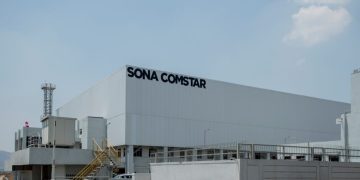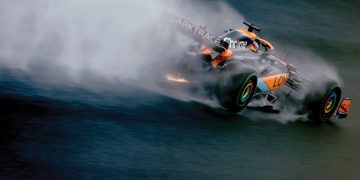After comparing the vehicle’s paint with the samples, and once the colour to be formulated has been selected, it is important that the preparation of the paint by mixing the basic colours that make it up in the proportion indicated by the manufacturer must to be done as accurately as possible, so that the prepared mixture faithfully corresponds to the established formulation. To achieve this, special attention must be paid, first of all, to ensuring that the balance used is perfectly calibrated and level; If this is not the case, it will hardly be possible to reproduce exactly the formula of the selected colour. Secondly, before extracting any quantity of paint, it is necessary to make sure that each and every one of the basic mixing colours that are going to be used, the pots have been previously homogenised; that is, they have been shaken to the extent necessary to ensure that the amount of paint extracted from them corresponds to the mixture of all the components. If this is not done, if a quantity of paint is extracted without homogenising the mix from the pot, it will not only influence the result of the colour that is being prepared, but also the rest of the paint contained in the basic pot will also be altered (if a quantity of non-homogenized material is extracted, the one that remains in the pot will not correspond to the mixture with the initial proportions either), which will alter all subsequent mixtures in which the altered basic colour is involved.
Extracting paint from a basic mix without first shaking it spoils the colour that is being prepared and makes the rest of the pot useless to prepare other mixes.
Depending on the type of paint, this homogenization can be more or less easy to carry out, from being enough with a couple of manual movements of the can, to having the cans arranged in a mechanism that allows a more intense agitation by introducing an agitator inside each pot, agitators that are activated jointly in all the mixing basics arranged on the different shelves of the traditional “mixing machine”.
Once these requirements have been fulfilled, it must be as exact as possible in the addition of the amounts indicated by the formula of each of the basic ingredients that are involved in the formulation of the colour that is being prepared. With special attention in cases where the amount of one of the basics is very small for the total volume to be prepared, since, in these cases, small differences with respect to the amount that really has to be added are very noticeable in the final result. This can be perfectly understood with the following examples: If the formulation of a Grey colour results from mixing 50g of White and another 50g of Black, and an error is made, and 51g of Black are added to the 50g of White, that is to say, one gram more than the indicated formula, and although in any case it is an unacceptable measurement error (one gram of difference in the measurement of a basic is a lot in the environment of the quantities prepared in refinish), it is true that the Grey obtained, although it will be different from the one that was intended to be obtained, this difference will be small and barely perceptible; especially if we compare with the following assumption, in which the formula of another shade of Grey consists of mixing 98g of White and 2g of Black. In this case, if we make the same absolute mistake as in the previous case, that is, add 3g of Black. One gram more, as in the previous case, but although in the first case the error meant adding 2% more than the amount indicated in the formula, in this second case it represents 50% more, so it is easy intuit that the colour obtained will be completely different from the one that was intended to be reproduced.

The smaller the quantity of a basic to be added to a formulation, the greater the accuracy that must be put into its measurement.
In some cases, the proportion in which one or more basics enter the colour formulation is so small that in order to ensure measurements with a minimum of accuracy, manufacturers propose a minimum amount of paint to be prepared. It is in these cases that greater care must be taken in weighing the components. This usually happens in Whites, in which in addition to the basic White, very small amounts of other basics (Blue, Yellow, etc.) are added.
The last aspect that we comment on regarding the preparation of the paints is the one referred to the dilution and/or catalysation of the mixture in the moment prior to the application. It must be done with the products indicated by the manufacturer depending on the application conditions; such as the appropriate diluent at the ambient temperature at which the airbrush application is to be carried out. The same with hardeners or catalysts, in the case of single-layer paints, or two-layer bases to which it is necessary to add the activator according to the required painting process; and always with the products indicated by the manufacturer and in the indicated proportions.
Paint and Clearcoat Application
Also during the aerographic application of the paint we find factors that condition the colour matching: The spray guns used must always be clean before each use; Obviously there can be no traces of paint from previous processes that would mix with the paint to be applied. The configuration of the gun parameters must be those indicated for each product to be applied, nozzle diameter, pressure, flow rate, etc.
Regarding the environmental conditions of temperature and humidity, during the application they must be within the margins described by the manufacturer; and in case of being in the limits of these, use the suitable diluents and catalysts at that temperature. With all this, it is ensured that the evaporation of the volatile components of the paint is carried out in the way designed by the manufacturer; Otherwise, too rapid evaporation could occur in some areas, which would result in the pigments not settling uniformly throughout the painted area, with areas appearing with different shades.

On the other hand, it is essential to respect the evaporation times between the application of each coat, since, if this is not the case, in addition to creating other paint defects such as sagging, the final appearance of the paint is also affected since they will evolve from It forms the pigments present in the paint differently, especially in the case of metallic and pearlescent pigmentations. In this sense, it should also be noted that it is especially important in metallic and pearl finishes, the completion of the application of the colour base with a last lighter and more extensive application coat that is usually called a “control coat” to help the equalisation of the finish in all the painted extension.
In colour matching, using the blending technique is always a winning trick: In the case of two-layer finishes, in which, after applying the colour base, the process is completed with the application of a clear coat that will completely cover the piece, or pieces, to be painted, regardless of whether the necessary colour has been properly identified, and the mixture has been prepared following all the advice listed above, whenever possible, in the case of repaired pieces, the application of the base will be preferable of colour using the blurring technique. This technique consists of, for example, once the deformed area in a piece has been repaired, and the primers have been applied and sanded, instead of applying a complete coat of primer to the entire piece, do it in larger and larger extensions, around the repaired area, in this way a gradual transition is achieved between the pre-existing paint on the piece with the new layer of paint, so if there were a slight difference in colour between the two layers it would be almost imperceptible. In addition, in the case of metallic finishes, in which the final effect achieved depends, in addition to the formulation of the colour used, on the way the paint is applied (application distance, sweep speed, since, according to In this case, the metallic pigment particles will be oriented in one way or another, obtaining results of different degrees of brightness according to different viewing angles.
Regarding the last layer of paint to be applied in the case of double and triple layers, that is, the clearcoat, although in principle it is a transparent layer that should not affect the colour, it can be done when the clearcoat used is not suitable for these processes; a low-quality product usually translates, among other parameters, to yellowing over time, which will undoubtedly affect the colour. It should also be borne in mind that an excessive thickness of clear coat should not be applied, in addition that the protection qualities are not improved, the tonality of the clearcoat becomes more evident the greater the thickness applied.
In two-layer paints, the best repainting option in cases of minor damage is the application of the two-layer bases using the blending technique.

Finally, we also point out that there are occasions in which the design of the paint finish of some colours includes the use of tinted clearcoats, that is, dyes are added to the clearcoat. These are chromatic pigments with very low covering power, with them it is achieved that, while maintaining transparency, the clear coat acquires the tonality of the dye, with which the final finish takes on a different appearance, which will also depend on the thickness or number of coats of the applied tinted clearcoat. In these cases, this aspect must be taken into account for the preparation of the samples to compare with the vehicle to be painted.
National Business Development Head – Automotive Business,




























































